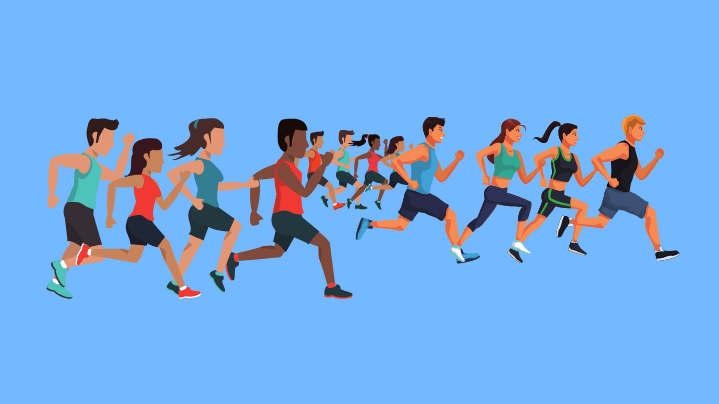No matter what your ultimate goals are, there’s simply no sport or exercise like running. You can run around the block, do marathons, run by yourself, or run with a group.
I started running to lose weight, but quickly realized how running was improving my overall health, and getting my muscles fit and toned. Now that I’m older, the cardio benefits provided by running are important to my overall running strategy.
I could go on and on about the benefits of a regular running regime, but back to:
Which Areas of the Body Do You Work Out When Running?
If you’re just thinking of taking up running, it won’t take you long to realize that a good run works several different groups of muscles in your body. If you’re out of shape, you might even think it worked your eyelids during the first few runs.
Muscles Worked Out When Running
- Quads for strength in the hip and pelvis
- Ham Strings to move the knee joint Hip
- Flexors to Support the hip
- Calves flex the ankle and knee
- Feet and ankles
Working Out the Primary Muscle Groups
It stands to reason that running with your legs will first and foremost work out the large lower body muscle groups in your legs. Your quads, hamstrings, calves, hip flexors, and butt muscles are going to be stroking and stoking.
- Your quads are the muscles on the front of your leg. They’re the big muscle between your hip and knee, and are used to extend and move your leg in a forward motion.
- Hamstrings are on the back side of your leg. They’re opposite of your quads and are responsible for lifting and helping your knees bend your leg backwards and up with each stride.
- Hip flexors are to help stabilize your body and to aide in bringing your foot and leg up.
- You know where your calf is: behind your knee extending to your ankle. Calves help you flex your knee and ankle.
- The Gluteus Maximus is your butt muscle and besides looking sexy, it’s there to help support and maintain your upper body in an upright position.
Muscles Supporting Primary Muscles When Running
You may think that only your legs and buttock muscles are in play when you’re running, but it’s going to take your upper body area to keep you upright, in motion, and breathing. Even though these aren’t leg muscles, they are still playing a part in your motion and mobility when running:
- Your biceps on the front of your upper arm are in the contracted position as you run with arms bent 90 degrees at your elbows, as most runners do.
- I find it almost impossible to run without moving my arms back and forth from my shoulders in rhythm with my feet. The triceps on the back of my arm and my shoulder muscles are always hard at work when I’m running or jogging.
- Running involves abdominal core muscles to help keep you upright, maintain your running posture, and balance. Your back muscles are supporting your spine while your stomach muscles are helping to lift your legs. These core muscles are helping your diaphragm draw in and dispel all the air you need.
Supplementary Muscles Supporting Your Running Efforts
Have you heard of intercostal muscles? Both internal and external muscles are between your ribs and make up the chest wall. They are used when inhaling and exhaling, so when you’re running, they are hard at work, expanding and contracting.
Running Affects Your Heart
We’ve been talking about the muscles hard at work while you’re running, but don’t forget that includes your heart. In fact, your heart muscle is not unlike any other muscle in your body and must adapt to your exercise efforts. Running is good for your heart and circulatory system because, like other muscles, exercise makes it stronger and forces more blood and nutrients throughout your entire body.
Running regularly will most likely result in a lower resting heart rate because the exercise strengthens your entire circulatory system, allowing your heart to beat less frequently when you rest.
Your Knees Are Hard At Work
You might hear that running is hard on your knees, and I don’t really have an opinion on that. On the one hand, it makes sense that there is a lot of weight pounding down on them with each step.
However, I think we were built to use all of our joints in both walking and running.
One thing I do think is that if you’re just starting out, learn to take your time as you gradually teach your body and your knees to adjust to the added stress.
I mean, really? Why would you think you could be a couch potato today, start running tomorrow, and enter a 5K run in a couple of weeks.
Training means gradually allowing your body to build up muscles, lungs, and heart, as well as getting your knees and hips accustomed to exercise. Running is the simplest sport to get into, but you’ll need to know about:
- Side Stitches
- What to wear
- How many days a week to run
- Warming up for a run
- Stretching
- Protecting your knees with knee sleeves
Running is a great form of cardio exercise that can provide many health benefits. When you are running, your body is working in a coordinated effort to move you forward.
The primary areas of your body that are targeted during running include the legs, particularly the quadriceps, hamstrings, and calves, as well as the core. Additionally, running also works out the cardiovascular system, improving your overall fitness and endurance.
In the end, I consider running such a great exercise for my body because virtually every area of my body is at work while my mind has a chance to rest.
